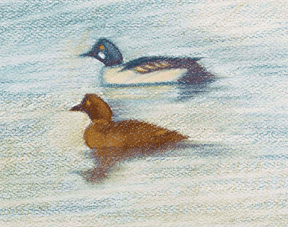
|
Volume XVII, Issue 8 - February 19 - February 25, 2009
|
|
Columns Reviews |
 |
Earth Journal by Gary Pendleton
Goldeneyes in February’s Rafts
Look for these diving sea ducks along the Bay
For most of January, a boxy watercraft peopled by a few shotgun-wielding sportsmen floated just off the North Beach boardwalk between Second and Third streets. Every hour or so, a few blasts sounded. For the most part, the ducks kept their distance.
With duck-hunting season over, the guns have stopped. Since then, modest flocks of canvasbacks, scaup and buffleheads have landed in the area the hunters recently vacated. I’ve been scanning the flocks to see if I can find a goldeneye among them, but I am not seeing many.
One benefit of this winter’s cold weather is the small flocks — or rafts — of Chesapeake Bay waterfowl on the water. It is refreshing to see flocks of wildfowl scattered here and there over the water, especially when skeins of geese and ducks move through the sky above. Sometimes the flocks come in for a picturesque landing or fly by in the golden light.
I’ll keep checking boldly patterned, good-looking, stocky ducks with large blocky heads. Common goldeneye males have dark green heads with a large white spot below their golden eyes. Their sides are bright white, with black on the back and tail. The females have brown heads and gray bodies.
Goldeneyes are informally grouped along with their close cousins, the buffleheads and mergansers, as sea ducks or divers. Dabblers are another informal group that includes mallards and others that merely tip into the water without diving to feed on vegetation. The divers propel themselves underwater with their feet to reach such food as mussels and clams.
In the winter, goldeneyes congregate on rivers and bays. In the east, they can be found along the coast from the Canadian Maritimes south to Georgia, and inland on rivers and lakes. At the end of winter, the Chesapeake flocks will migrate north to Canada, where they will make their nests in tree cavities near freshwater ponds and rivers.
|
Scientific names: Becephela clangula What to look for: Boldly patterned, stocky ducks with large blocky heads. Males have dark green heads with a large spot under their golden eye. Their flanks are white and their tales and backs are black. Females have brown heads and gray bodies. Where to look: Rivers and bays. Places to visit: North Beach Boardwalk, Downs Park. |